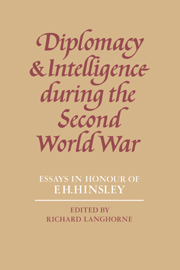Book contents
3 - F. H. Hinsley and the Cambridge moles: two patterns of intelligence recruitment
Published online by Cambridge University Press: 21 September 2009
Summary
Cambridge University occupies a remarkable place in the modern history of both the British and the Russian intelligence communities. It has produced a long line of British intelligence officers from Christopher Marlowe, the first in a series of British secret agents who have achieved literary success, to Sir Colin Figures, the present head of the Secret Intelligence Service (SIS or MI6). That distinguished line includes Professor Harry Hinsley, who was recruited as a wartime cryptanalyst in Bletchley Park while still an undergraduate. But Cambridge has also provided a smaller number of able recruits to the KGB. When the KGB approached Kim Philby he ‘did not hesitate’. ‘One does not look twice’, he writes snobbishly, ‘at an offer of enrolment in an elite force’. Remarkably, the KGB began its recruiting in inter-war Cambridge several years before British Intelligence.
Sympathy for the Soviet Union in Cambridge has always been limited. But it was much less restricted in the early 1930s than in the immediate aftermath of the Bolshevik Revolution. That greater sympathy had more to do with events in Britain than with events in Russia. What Philby considered ‘the real turning-point’ in his own political development came, as for many other left-wing intellectuals, with ‘the demoralisation and rout of the Labour Party in 1931’. The great ‘betrayal’ of Ramsay MacDonald's National Government in August 1931 was followed by Labour's humiliation in the general election two months later.
- Type
- Chapter
- Information
- Diplomacy and Intelligence During the Second World WarEssays in Honour of F. H. Hinsley, pp. 22 - 40Publisher: Cambridge University PressPrint publication year: 1985
- 2
- Cited by



